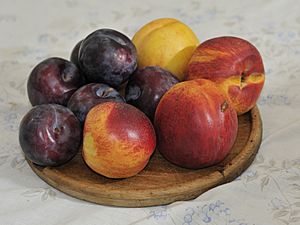Prunus subg. Prunus facts for kids
Quick facts for kids Prunus subg. Prunus |
|
|---|---|
 |
|
| Plums and nectarines | |
| Scientific classification |
|
| Kingdom: | Plantae |
| Clade: | Tracheophytes |
| Clade: | Angiosperms |
| Clade: | Eudicots |
| Clade: | Rosids |
| Order: | Rosales |
| Family: | Rosaceae |
| Genus: | Prunus |
| Subgenus: | Prunus subg. Prunus |
| Section | |
|
See text. |
|
Prunus subg. Prunus is a special group of plants within the larger Prunus family. This group includes many tasty fruits like plums, apricots, and bush cherries. Most fruits in this group are sweet and soft. They store a lot of energy, which makes them a great snack!
Scientists used to group some plants differently. But new studies, especially one by Shi et al. in 2013, showed that almonds and peaches also belong in this Prunus subg. Prunus group. This helps us understand how these plants are related.
Contents
How Scientists Group These Plants
Scientists like Shi et al. (2013) divide Prunus subg. Prunus into seven main sections. Think of these sections as smaller families within the big group. These sections are: Amygdalus, Armeniaca, Emplectocladus, Microcerasus, Persicae, Prunocerasus, and Prunus.
These seven sections can be further grouped into three bigger "clades" or branches. One special branch is called sect. Emplectocladus. The other two main branches are the Amygdalus-Persicae group (which includes almonds and peaches) and the Armeniaca-Microcerasus-Prunocerasus-Prunus group (which includes apricots, bush cherries, and plums).
Sect. Emplectocladus
Prunus sect. Emplectocladus is like the oldest branch of this plant family. It's sometimes seen as its own separate group. This section includes six types of plants found in the New World (North and South America).
- Prunus fasciculata – known as the desert almond
- Prunus cercocarpifolia
- Prunus eremophila – another desert almond
- Prunus havardii – Havard's wild almond
- Prunus microphylla – Mexican wild almond
- Prunus minutiflora – Texas wild almond
Sect. Amygdalus & Sect. Persica
These two sections, Prunus sect. Amygdalus and Prunus sect. Persica, are very closely related. They often form one big group. The word "ămygdălus" is a Latin word for the almond nut.
Sect. Amygdalus includes most types of almonds from the Old World (Europe, Asia, Africa).
Selected species:
- Prunus arabica – Arabian wild almond
- Prunus dulcis – the common almond
- Prunus fenzliana
- Prunus spinosissima – thorny almond
Sect. Persica includes different kinds of peaches. It also has two species that were once thought to be almonds.
- Prunus davidiana – Chinese peach
- Prunus ferganensis – Fergana peach
- Prunus kansuensis – Gansu peach
- Prunus mira – Tibetan peach
- Prunus mongolica – Mongolian almond
- Prunus persica – the common peach
- Prunus tangutica – Tangut almond
Sect. Armeniaca
Species in Prunus sect. Armeniaca are all types of apricots. These plants originally come from Eurasia.
Selected species:
- Prunus armeniaca – the common apricot
- Prunus mandshurica – Manchurian apricot
- Prunus mume – Japanese apricot
- Prunus sibirica – Siberian apricot
Sect. Microcerasus
Plants in Prunus sect. Microcerasus are often called bush cherries or dwarf cherries. They are smaller than regular cherry trees.
Selected species:
- Prunus glandulosa
- Prunus japonica
- Prunus prostrata
- Prunus pumila
- Prunus tianshanica
- Prunus tomentosa
Sect. Prunocerasus
Prunus sect. Prunocerasus includes many types of plums found in the New World. It also includes a plant called peachbush.
Selected species:
- Prunus americana – American plum
- Prunus angustifolia – sand plum
- Prunus maritima – beach plum
- Prunus mexicana – Mexican plum
- Prunus nigra – Canada plum
- Prunus texana – peachbush
Sect. Prunus
Prunus sect. Prunus includes many types of plums that come from the Old World.
Selected species:
- Prunus cerasifera – cherry plum
- Prunus domestica – European plum
- Prunus salicina – Chinese plum
- Prunus simonii – apricot plum
- Prunus spinosa – sloe
Images for kids
See also
 In Spanish: Prunus subg. Prunus para niños
In Spanish: Prunus subg. Prunus para niños







